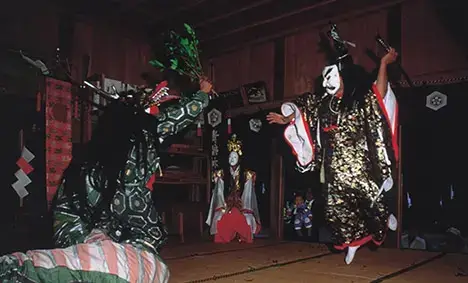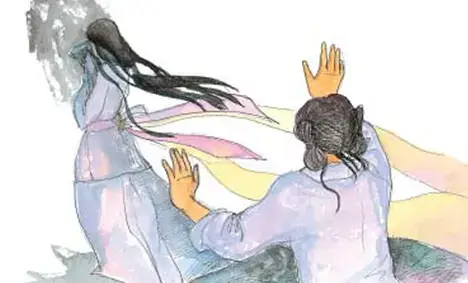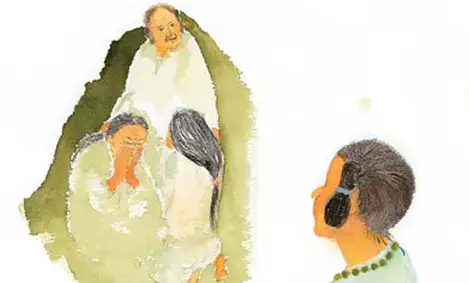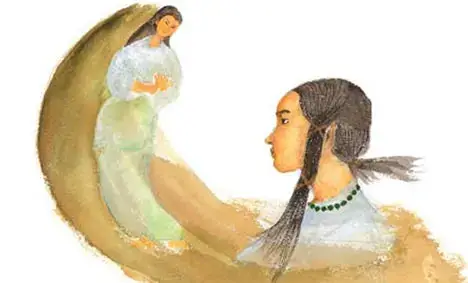第一章History of Izumo, Chapter 1
Japanese Mythology

Why is Izumo called the birthplace of Japan?
The city of Izumo includes many settings from Japanese mythology, which tells the story of Japan's origin. Japanese mythology is recorded in the stories of the Kojiki (Records of Ancient Matters) and Nihon Shoki (The Chronicles of Japan), and it is believed that one third of the Kojiki’s text is about or concerned with Izumo.
* Japanese mythology: A mythology that illustrates Japan's spirituality and sense of values through the acts of gods.
What is the Kojiki (Records of Ancient Matters)?
Japan's oldest history book, which was presented to the Emperor of Japan in 712. It is said that a group of government officials of the Imperial court led by Oono Asomi Yasumaro compiled the book based on traditional folklore. The original copy no longer exists, but several manuscripts have been passed down. Historical events, myths, and legends from the beginning of the world up to the era of Japan's first empress, Empress Suiko (early 7th century), are recorded.
WikipediaWhat is the Nihon Shoki (The Chronicles of Japan)?
Japan’s oldest official history, established in the Nara period (8th century), and passed down through generations. It was compiled by a group led by Prince Toneri of the Imperial family, and was completed in the year 720. It writes about events from early Japanese mythology up to the era of the Emperor Jito (end of 7th century).
WikipediaTogether, the Kojiki and Nihon Shoki are generally known as "the Kiki.”
A myth or a real story?
There are some archaeological sites that support the stories told in the Izumo Myths. Valuable bronzeware discovered in the Kojindani ruins allows us to feel even closer to the world of this mythology.
Besides the Kojidani ruins, you can also learn more about the history of the Yayoi period by visiting the Izumo Yayoi no Mori Museum, and more about ancient Izumo by visiting the Shimane Museum of Ancient Izumo, which is close to Izumo Taisha Grand Shrine.
Shimane Museum of Ancient IzumoThis museum near Izumo Taisha Grand Shrine lets you experience firsthand the world of mythology.
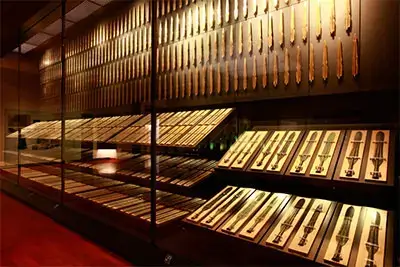
With Izumo Taisha Grand Shrine as its main focus, this museum displays exhibits about ancient Izumo. Its collection includes 358 bronze swords, 16 bronze spearheads, and 6 dotaku (bronze bells), all excavated from the Kojindani ruins, among which are national treasures. Also featured are 39 dotaku (all national treasures) excavated from the Kamo Iwakura ruins.
There are also exhibitions on the Iwami Ginzan (Iwami Silver Mine) and other exhibits that involve the whole history of Shimane Prefecture. In the central lobby, you can see displayed a pillar called Uzubashira, which was excavated from the grounds of Izumo Taisha Grand Shrine in 2000. You can also see a 1:10 scale replica of the main shrine building of Izumo Taisha Grand Shrine as it was thought to be in the Heian period.
Shimane Museum of Ancient Izumo
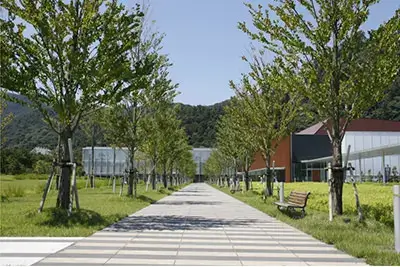
Here, you will see many things such as replicas of possible ancient forms of Izumo Taisha, an incredible collection of copper swords and bells discovered in the area, exhibits about the life described in the “Izumo no Kuni Fudoki” (a book from the 8th century), and three enormous cedar pillars discovered in 2000 after an excavation at Izumo Taisha, believed to be a part of the original ancient shrine.
WebsiteKojindani RuinsArcheological ruins where as many as 358 bronze swords, a symbol of authority, were discovered
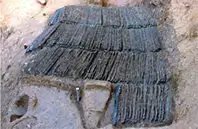
Excavation of this site began after sue ware from the Kofun period was found in 1983. During the investigation (which took place in 1984-1985), 358 bronze swords, 6 dotaku and 16 bronze spearheads were excavated. The bronze swords, dotaku and bronze spearheads were known collectively as the “Shimane Kojindani Ruin Artifacts,” and were all declared national treasures in 1998.
The ruin was declared as a national historic landmark in 1987, and the entire ruin was established as Kojindani Historical Park in 1995. Then in 2005, the Kojindani Museum was opened. It displays seasonal exhibitions of artifacts.
The number of bronze swords excavated at the Kojidani ruins is the largest number of such swords in Japan to be discovered in at one site, and this discovery was a huge shock to the world of ancient Japanese history and archeology. Thus, the image of Japan as a country with no substance to its mythology was dispelled.
Presently, the artifacts discovered at this site are featured in the permanent exhibit at the Shimane Museum of Ancient Izumo, which was opened in March 2007.
Izumo Yayoi no Mori MuseumMeet the chiefs of Izumo from the Yayoi period and their valuable artifacts

The ancient kingdom of Yamataikoku was ruled by Queen Himiko in the Yayoi period. During this era, Izumo was home to a giant burial chamber for powerful rulers. With a glance at glass magatama beads, bracelets, grave goods painted in vivid red pigment, you are invited back to the Yayoi period to see the world of Izumo’s ancient chiefs, restored boldly in a huge diorama model of the funeral of a chief of Izumo.
This museum serves two purposes, not only as a guidance facility presenting every ruin within the city (such as the nearby nationally designated historic site Nishidani Tumulus), but also as an archaeological center for cultural properties excavated in investigations within the city.
The grave of Izumo no Okuni, the founder of kabuki theater
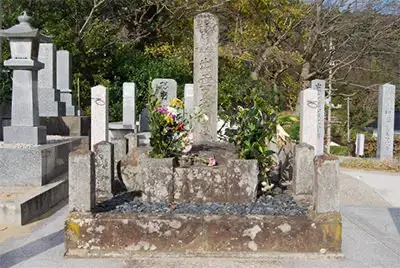
The founder of Japan’s unique and popular Kabuki style of theater is said to be Izumo no Okuni, who was a shrine maiden at Izumo Taisha Grand Shrine.
Izumo no Okuni’s grave is located on the path from Izumo Taisha to Inasa no Hama Beach.
Izumo, the land where ancient and modern meet

Izumo Taisha Grand Shrine seems to tower above as a symbol of Izumo, the land of the gods. With Mt. Yakumoyama in the background, this is a quiet place with a dignified air to it as the elegant shrine looms majestic. There is a sense that the things here are larger than life, and a solemn tension in this place.
From the grandiose atmosphere of Izumo Taisha Grand Shrine, you can feel both of the existence of Great King of the Land (Okuninushi no Okami) and his generosity as the god of luck and wealth.
Izumo Taisha Grand Shrine is full of massive things. The tremendous roof of the main shrine with its towering chigi (forked roof ornaments), life-size bronze statues of Okuninushi no Okami, and oshimenawa (straw rope marking ritual purity)…the list goes on. Even now, the main shrine still proudly takes first place as the largest in Japanese shrine architecture, and it is believed to have been twice its current height in the Heian period (794-1185), measuring up to 48 meters.
You may find yourself wondering, “Did the people of that time have the architectural technology needed to build something of that height?” This question has been the subject of legends for a long time. However, in the year 2000, on the grounds of Izumo Taisha, a pillar said to be from ancient times was found: the Uzu pillar (Uzubashira),a giant wooden pillar. It was a major discovery which held the key to solving the mystery of “the Giant Shrine of Ancient times,” and it attracted a lot of attention as it proved the giant size of the ancient main shrine. One of the discovered pillars (Shin-no-mihashira) is exhibited as part of the treasure palace inside the shrine grounds, and the Uzu pillar is on display at Shimane Museum of Ancient Izumo.
Uzu pillar (Uzubashira)
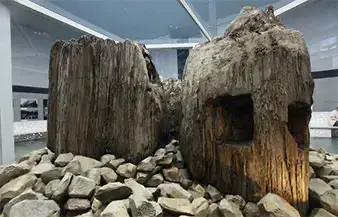
Between 2000 and 2001, pillars were found at three different places within the grounds of the ruins of Izumo Taisha Grand Shrine, each made of three giant cedar trees as a set, with a diameter of about 3 meters.
One of these was a pillar which supported the ridge of the roof (Munamochibashira), which has come to be called the Uzu pillar (Uzubashira) since long ago. Inside the holes where the pillars were placed, which had radius up to about 6 meters, there were tightly packed stones, the size of a human head or bigger. It was clear that there was no precedent for this kind of underground structure elsewhere in the world.
The location and structure of the pillar was found to bear a striking resemblance to drawings in the alleged blueprint of the giant main shrine “Kanawa no Gozouei Sashizu.” With this, in addition to scientific analysis and investigations of archaeological documents, it seemed ever more possible that this pillar could have supported the main shrine built in 1248 during the first half of the Kamakura period
Main shrine of Izumo Taisha Grand Shrine
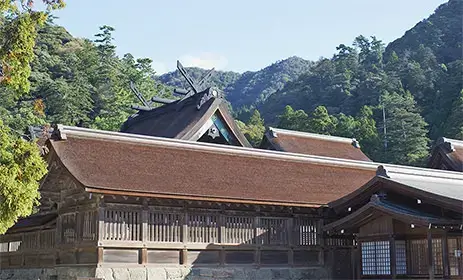
The main shrine of the Izumo Taisha Grand Shrine was called Unta in the 10th century, and it is said to have been the tallest shrine in Japan, boasting 48 meters. Shin-no-mibashira, the central pillar, had a diameter of around 3. 6 meters, and it is believed that the length of the staircase leading to the main
Izumo Taisha Grand Shrine – Narabi-ni-Shingozu
There is an illustration depicting Kizuki Grand Shrine (now known as Izumo Taisha) and its surroundings in the Kamakura period. According to one theory, this is a picture from a partitioning screen which was offered to the main shrine when it was built in 1248.
The scope of the drawing mainly focuses on the grounds of Izumo Taisha, and generally the ancient Kizuki area and its surroundings, illustrating in particular detail the west part of the Shimane Peninsula.

In the upper side of the Japan Sea on the illustration, you can see a sailing ship carrying goods, and close to the Inasa no Hama Beach, you can see a fishing boat. The huge vermillion-lacquered shrine in the center of the illustration is said to be that of the sanctuary, erected in 1248, towering much higher than the other buildings.
The big building to the left side of the grand shrine is the house of the regional administrator of Izumo, and besides this, there are a variety of buildings illustrated separately, such as buildings made of pillars sunk into the ground, and buildings surrounding the shrine’s fence. To the south side of the shrine grounds, you can see a harvested rice field extending from east to west, and to the right are 2 or 3 objects which appear to be small puddles. This is a pond called Hishineike, which disappeared about 400 years ago, due to the development of new rice fields. On the southern side dunes, you can see deer with antlers. Deer still roam wild on Mt. Kitayama behind the Grand Shrine.
Moreover, Izumo Taisha Grand Shrine is also well known for being home to the god of fate (enmusubi) and of wealth. In the Kojiki (Records of Ancient Matters), which is believed to be the Japan's oldest history book, you can even find the information about the foundation of the ancient shrine. Up to the Meiji Era, it was called Kizuki Grand Shrine.
The main god worshiped here is Okuninushi no Okami, who is also well known in Japan as Daikoku-sama. In the Kuniyuzuri myth (transfer of the land) told in the Kojiki, Okuninushi no Okami gives over his country to Amaterasu Omikami in the Heavens. Amanohisuminomiya shrine which was built at the end of this myth is said to be the original Izumo Taisha Grand Shrine.
Takamagahara – The Heavens
The world of heaven in Japanese mythology. In the myths of the Kojiki, there are said to be 8 million gods and Amatsukami (heavenly gods) who were ruled over by Amaterasu Omikami. The Kojiki states that the world where the people lived is called Ashihara no Nakatsukuni, while the realm of the dead which was believed to exist inside the earth is called Yomi no Kuni.
Inasa no Hama Beach

A shoreline featured in Japanese mythology. It is said that the messengers of heaven stuck their swords on this beach and negotiated with Okuninushi no Okami in the Kuniyuzuri myth (transfer of the land). It is written in Izumo no Kuni Fudoki that Sono no Nagahama, which extends to the south from here, became the rope described in the Kunibiki legend (pulling together the land). Bentenjima seems to float on the beach, complementing the coastal landscape.
Kamiarizuki – when all the Gods from throughout Japan gather in Izumo This week-long festival is cerebrated quietly and peacefully.
In the tenth month of the old lunar calendar, 8 million gods (Yaoyorozu no kami) from all over Japan gather in Izumo.
In most of Japan, all the gods are away this month, so it is called, “Kannazuki,” but Izumo is where the gods gather, so only in this region, the month is called “Kamiarizuki.”

Every year, there is a festival to celebrate the welcoming of the gods on the 10th day of the 10th month of the lunar calendar. It is a ritual that takes place nearby Izumo Taisha Grand Shrine on the coast of the Sea of Japan at Inasa no Hama Beach, where ritual fires are lit and dragons and sea snakes are welcomed as messenger of the gods.
After the gods have been welcomed at the shore, a march to Izumo Taisha starts to the sound of flute and drum with two sacred tree branches called Himorogi housing dragons, sea snakes, and gods at the head. After the celebration at Izumo Grand Shrine, it is said that the eight million gods will stay in Izumo for a week, in the nineteen shrines to the east and west sides of the main shrine, as they hold a meeting, called Kamuhakari, on various matters related to human life.
It is also said that during this meeting, the gods decide the fates of men and women who are destined to be together. This meeting takes place at Ue no Miya, located on the way to Inasa no Hama Beach. The people living here keep the practice of making no noise that would disturb the meeting, restraining themselves to live quietly during this time.
Lake Shinji
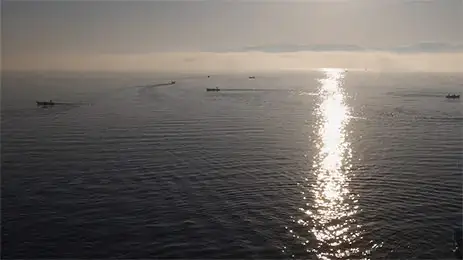
Located in the northeastern part of Shimane Prefecture, Lake Shinji is a long rectangular lake of about 17 km from east to west, about 6 km from north to south, and 47 km in circumference. Its surface area is the seventh largest in Japan.
Flowing through the Izumo plains, Lake Shinji’s main source is the Hiikawa River, famous for its role in the myth of Yamata no Orochi, and it is connected to 20 rivers to its north, south, east and west.
In 2005, it was registered to the International Wetland Convention “Ramsar Convention,” aimed at conserving wetlands. It's one of the one hundred scenic spots representing Japan. It is said to have been formed 10,000 years ago, and it is a beautiful lake with a deep connection to the land of Izumo. Lake Shinji in the late afternoon was also chosen as one of best 100 sunsets of Japan and the beauty of the clouds, sky and lake together was a subject of fascination for many literary artists, such as Koizumi Yakumo.
Hiikawa River

Originating at Mt. Sentsu of the Chugoku mountain range and flowing to the north, the Hiikawa River surges into Lake Shinji, making it a first-class river with a basin area of about 2,550 sq. km and a length of 153 km. The upper part is famous as the stage for the extermination of Yamata no Orochi, referred to as “Hinokawa” in the Kojiki, and as “Izumo Okawa” in Izumo no Kuni Fudoki. At the time it flowed westward from the Izumo plain, but the riverbank changed in the Edo period such that it now flows to the east.
Tachikuekyo Gorge
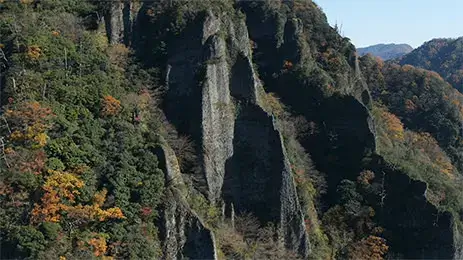
A rocky cliff face soars 100 to 200 meters tall for about 2 kilometers along the clear stream of the Kandogawa River. It was made by the erosion and weathering of the river, and on the left bank there are stunning rock formations such as “Candle Rock.” The weathering of rocks is intense, with cracks and fissures added by the erosion of rainwater, and many small valleys developing, making the terrain complicated. It was designated as a national scenic spot/natural monument in 1927, and became a prefectural natural park in 1964.
There are plenty of places to sightsee, such as a promenade which serves as a nature observation course, an observation deck, and a site known as Gohyakurakan (a collection of Buddha statues on the trail). The spectacular scenery and the changing sights every season make a new experience for visitors each time.
Tachikuesan Reikoji Temple
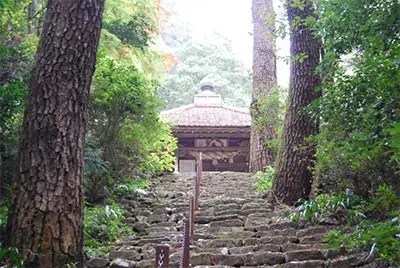
About 1,200 years ago, a monk heard a voice crying out from the river. As he went nearer, a big green turtle was floating with a Nyorai statue on its back. The monk placed this Nyorai in a cavern halfway up a rock shaped like a Buddha, called Tenchuuhou, and a temple was erected.
There is an oku-no-in (a temple enshrining the temple founder) near the top of Tenchuuhou. People do not live there, but it is said that in the dark of the night the sound of a mokugyo (a fish-shaped wooden drum used in Buddhist temples) can be heard. According to local legend enduring from long ago, this is the work of a tengu (long-nosed goblin) living in the area.
Gohyakurakan
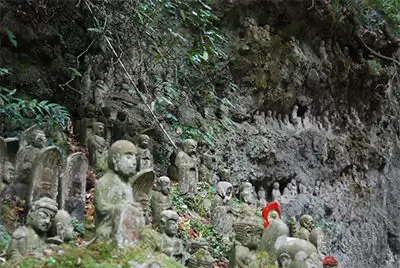
On the rock face just below the pilgrim path to Reikoji Temple, there is a dynamic collection of stone Buddha statues. These statues have been exposed to the elements for a long time, and there are more than 1000 in total, including objects that have partly decayed.
The oldest statues are wooden, and the stone statues are from about 100 years ago. All of them were given as tribute by the people who founded the temple.
Inome Shore

Mentioned in Izumo no Kuni Fudoki, the gateway to the land of the dead is said to be in the caverns of the Inome Shore. In these caverns, countless artifacts there have been discovered that tell the story of the lives and burial rituals of people from the Jomon period (14,000 - 300 BCE) to the Kofun period (300-538).
Gakuenji Temple
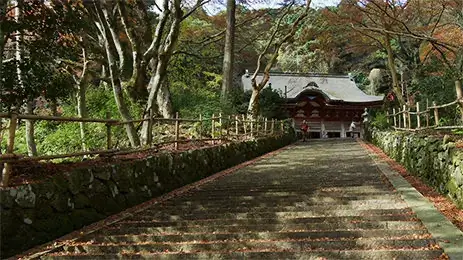
According to legend, in 594 the holy priest Chishun of Shinano Province went to Mt. Tabushi in Izumo in order to pray at a waterfall for a cure for the emperor’s eye sickness. Because the emperor was cured, a temple was built.
It is said that Musashibo Benkei engaged in ascetic practices there for three years from the age of 18 at the end of Heian period, and then met Minamoto no Yoshitsune at Mt. Hiei in Kyoto.
Saka Shrine

According to Izumo no Kuni Fudoki, this is the birthplace of the sake brewery. Even now, the shrine is licensed to brew 180 liters of sake each year, and at the annual autumn festival on October 13th, visitors to the shrine are treated to freshly made sake.
Kitajima Kokusokan

In 1882, Kitajima Naganori, the 76th Regional Administrator of Izumo, established the Shinto organization of Izumo-kyo, whose main shrine is located here.
Izumo-kyo is a type of Shinto which focuses on worshiping the god Okuninushi no Okami. At the main gate of the Kitajima Kokusoukan, there is a Yotsuashimon gate, a gate with four pillars, the oldest building of Izumo Taisha Grand Shrine.
Usagi District
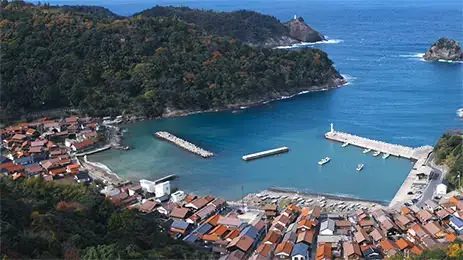
The Usagi District is a region facing the Sea of Japan beyond the mountain pass from Izumo Taisha Grand Shrine. It consists of the neighborhoods Udo and Sagiura, which are called Utahohama and Sagihama in Izumo no Kuni Fudoki. It is a small port town of the Shimane peninsula surrounded by the sea and the mountains, where you will surely feel at ease.


